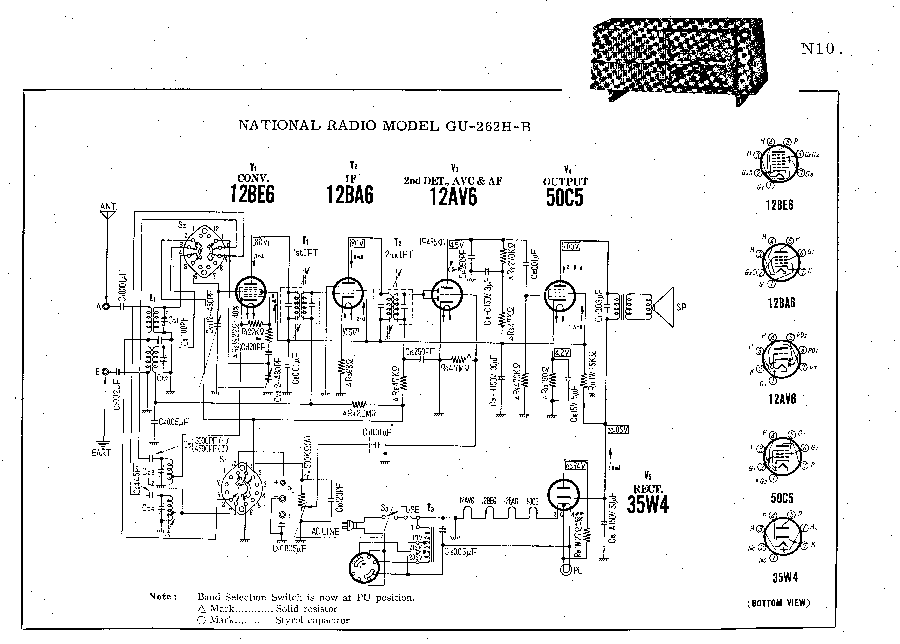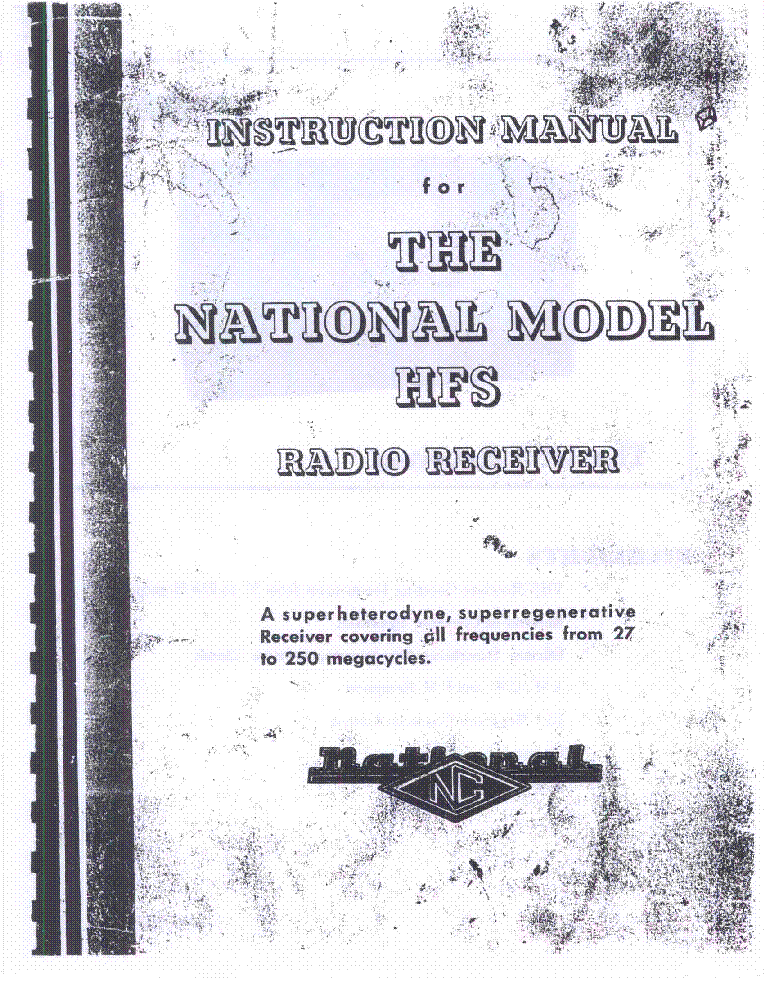Service manuals, schematics, eproms for electrical technicians
NATIONAL NC-57M RECEIVER.

Type:  (DJVU)
(DJVU)
Size
601.1 KB
601.1 KB
Page
21
21
Category
AUDIO
SERVICE MANUAL
AUDIO
SERVICE MANUAL
If you get stuck in repairing a defective appliance download this repair information for help. See below.
Good luck to the repair!
Please do not offer the downloaded file for sell only use it for personal usage!
Looking for similar national manual?
Good luck to the repair!
Please do not offer the downloaded file for sell only use it for personal usage!
Looking for similar national manual?
Document preview [1st page]

No preview item for this file.
Possible causes:
- No preview picture generated yet.
- It is not a pdf file.
Advertisements
Download free of charge (10 files / day):

Download processing...

Download processing...
- Also known:
NATIONAL NC-57M NC57M NC 57 57M
- If you have any question about repairing write your question to the Message board. For this no need registration.
- If the site has helped you and you also want to help others, please Upload a manual, circuit diagram or eeprom that is not yet available on the site.
Have a nice Day! - See related repair forum topics below. May be help you to repair.
Warning!
If you are not familiar with electronics, do not attempt to repair!
You could suffer a fatal electrical shock! Instead, contact your nearest service center!
Note! To open downloaded files you need acrobat reader or similar pdf reader program. In addition,
some files are archived,If you are not familiar with electronics, do not attempt to repair!
You could suffer a fatal electrical shock! Instead, contact your nearest service center!
so you need WinZip or WinRar to open that files. Also some files are djvu so you need djvu viewer to open them.
These free programs can be found on this page: needed progs
If you use opera you have to disable opera turbo function to download file!
If you cannot download this file, try it with CHROME or FIREFOX browser.
Translate this page:
Relevant AUDIO forum topics:
Sziasztok!
Vásároltam egy nagyon szép karcmentes AKAI GX-4000D-t. Használat közben észrevettem néhány bosszantó dolgot. Ha kis méretű 10cm-es orsót teszek fel rá és a szalag kezd lefogyni a leeresztő orsóról elkezd ingadozni a szalagsebesség (nyávog a készülék hangja). Megtakarítottam a fejeket, nyomógörgőt és a szalagpálya összes olyan alkatrészét ami a mágnesszalaggal érintkezik, és még mindig fennáll a hiba. Mi lehet a gond? Szorul a leeresztő orsó lejátszás közben (feszesre van állítva?), vagy mindenképp a nyomógörgő gumiborítását kell cserélnem? A másik bajom.: Szereztem hozzá rengeteg POLIMER, BASF, PHILIPS, MAXELL szalagot, de csak a MAXELL-re készít szép felvételt. Az összes többi szalagnál katasztrófálisan nagy mértékű a magas frekvenciás tartományban a veszteség (8kHz feletti frekvenciákon), akár egy mélynyomót hallgatnák vissza. Itt a 40 év feletti szalagok nem betervezett oxidációs elektrokémiai folyamata a bűnös vagy a magnetofon BIAS (100kHz) áramköre? Minden vélemény, gondolat érdekel!
Vásároltam egy nagyon szép karcmentes AKAI GX-4000D-t. Használat közben észrevettem néhány bosszantó dolgot. Ha kis méretű 10cm-es orsót teszek fel rá és a szalag kezd lefogyni a leeresztő orsóról elkezd ingadozni a szalagsebesség (nyávog a készülék hangja). Megtakarítottam a fejeket, nyomógörgőt és a szalagpálya összes olyan alkatrészét ami a mágnesszalaggal érintkezik, és még mindig fennáll a hiba. Mi lehet a gond? Szorul a leeresztő orsó lejátszás közben (feszesre van állítva?), vagy mindenképp a nyomógörgő gumiborítását kell cserélnem? A másik bajom.: Szereztem hozzá rengeteg POLIMER, BASF, PHILIPS, MAXELL szalagot, de csak a MAXELL-re készít szép felvételt. Az összes többi szalagnál katasztrófálisan nagy mértékű a magas frekvenciás tartományban a veszteség (8kHz feletti frekvenciákon), akár egy mélynyomót hallgatnák vissza. Itt a 40 év feletti szalagok nem betervezett oxidációs elektrokémiai folyamata a bűnös vagy a magnetofon BIAS (100kHz) áramköre? Minden vélemény, gondolat érdekel!
Sziasztok!
Pioneer autórádióba keresek végfok ic-t: PAL007B. Hazai forrás érdekelne, mert én nem találtam. Köszönöm!
Üdv
Sziasztok!
Néha javítok magnetofonokat.
Tipikus hiba a gumiból készült alkatrészek, szíjak, görgők elöregedése.
Hol lehet ezeket beszerezni?
Típus vagy mechanikai paraméterek alapján lehet keresni ezeket az alkatrészeket?
Üdv.: Kumi
Sziasztok!
A képeken egy kb. két éves, SteelSeries Arctis 1 vezetéknélküli fejhallgató hangerőszabályzó potmétere. Ellenálláspálya árkosra kopott, cserélni kéne. De sem szervizkönyvet, sem ezen az alkatrészen egy tìpusszámot nem látok.
Valakinek van esetleg ötlete, merre lehetne elindulni a keresésben? Nem hiszem, hogy ne gyártanának hasonlót se már, de ha legalább a poti gyártójára ráismer valaki, már akkor könnyebb lenne egy katalógus alapján elindulni..
Ha valaki rendelkezik kapcsolási rajzzal / szervizkönyvvel hozzá netán, amiben fel vannak tüntetve típusszámok, természetesen azt is megköszönném!
Tamás
Similar manuals:
If you want to join us and get repairing help please sign in or sign up by completing a simple electrical test
or write your question to the Message board without registration.
You can write in English language into the forum (not only in Hungarian)!
or write your question to the Message board without registration.
You can write in English language into the forum (not only in Hungarian)!
E-Waste Reduce




